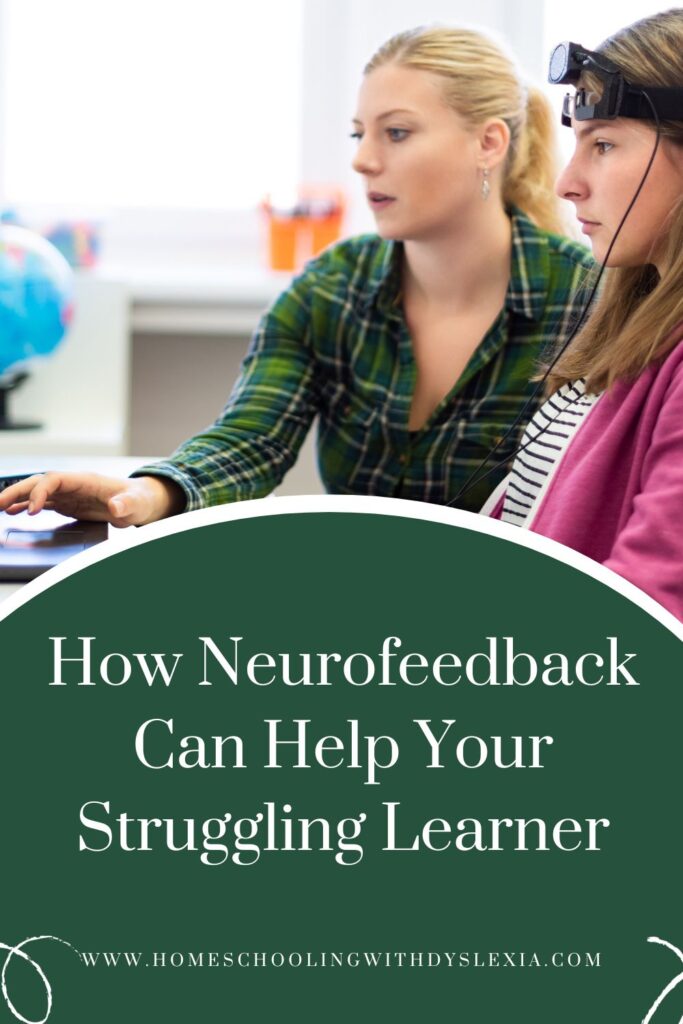Neurofeedback, a cutting-edge therapeutic technique, has emerged as a promising tool that combines technology, neuroscience, and psychology to reshape the way we understand and treat various learning difficulties. In this blog post, we will explore what neurofeedback is, how it can transform the brain, the myriad of issues it can assist with, and its particular power to manage Attention-Deficit/Hyperactivity Disorder (ADHD).

What is Neurofeedback?
Neurofeedback, also known as EEG biofeedback or neurotherapy, is a non-invasive form of brain training that helps individuals learn how to regulate their brain activity. It is grounded in the concept of neuroplasticity—the brain’s remarkable ability to reorganize itself by forming new neural connections throughout life. This innovative therapy involves monitoring and providing real-time feedback on an individual’s brainwave patterns, allowing them to gain better control over their mental states.
How Does Neurofeedback Work?
Neurofeedback begins with the placement of electrodes on the scalp to measure electrical activity in the brain, specifically focusing on the brain’s electrical patterns known as electroencephalograms (EEG). These EEG signals are then processed by a computer, which translates them into visual or auditory feedback that the individual can perceive in real-time.
Through this feedback, individuals become aware of their brain’s current state and are encouraged to make conscious changes. Over time, with consistent training, the brain learns to modify its own activity patterns. The goal is to encourage healthier and more balanced brainwave patterns associated with improved cognitive function and emotional well-being.
Neurofeedback and Brain Transformation
Neurofeedback has the potential to reshape the brain in several significant ways:
- Enhanced Connectivity: Neurofeedback can facilitate the formation of new neural pathways, enhancing communication between different regions of the brain. This improved connectivity can lead to better cognitive functions, such as memory, attention, and problem-solving.
- Regulation of Brainwave Patterns: Neurofeedback helps individuals regulate their brainwave patterns, optimizing their mental state. This can lead to reduced stress, anxiety, and depression, as well as improved focus, creativity, and emotional stability.
- Improved Self-Regulation: Neurofeedback teaches individuals to gain better control over their thoughts, emotions, and behaviors. This increased self-regulation can be especially beneficial for those with impulse control issues, such as ADHD.
What Can Neurofeedback Help With?
Neurofeedback has shown promise in addressing a wide range of neurological and psychological issues. Here are some of the conditions and challenges it can assist with:
- ADHD: Attention-Deficit/Hyperactivity Disorder is one of the most well-studied applications of neurofeedback. By training individuals to enhance their focus and impulse control, neurofeedback can help reduce the core symptoms of ADHD.
- Anxiety and Depression: Neurofeedback can promote relaxation and alleviate symptoms of anxiety and depression by encouraging the brain to produce more balanced brainwave patterns.
- Post-Traumatic Stress Disorder (PTSD): Neurofeedback has been used to treat PTSD by helping individuals reprocess traumatic memories and reduce hyperarousal.
- Insomnia and Sleep Disorders: By training the brain to achieve more relaxed states, neurofeedback can improve sleep patterns and alleviate insomnia.
- Autism Spectrum Disorders: Neurofeedback has been explored as a potential therapy to enhance social and emotional functioning in individuals with autism.
- Traumatic Brain Injury (TBI): Neurofeedback can aid in the recovery process by promoting neuroplasticity and improving cognitive functions following a TBI.
- Substance Abuse and Addiction: Neurofeedback can help individuals manage cravings, reduce impulsive behavior, and increase their ability to resist substance abuse.
- Peak Performance: Athletes, musicians, and professionals in various fields use neurofeedback to optimize their cognitive and emotional states, ultimately enhancing their performance.
Neurofeedback and ADHD
Attention-Deficit/Hyperactivity Disorder is a neurodevelopmental disorder characterized by symptoms such as inattention, hyperactivity, and impulsivity. Neurofeedback has garnered attention as a potential non-pharmacological intervention for managing ADHD. Here’s how neurofeedback can be beneficial in addressing this condition:
- Improved Self-Regulation: Individuals with ADHD often struggle with impulse control and regulating their attention. Neurofeedback helps them learn to regulate their brainwave patterns, leading to better self-control and sustained attention.
- Targeted Training: Neurofeedback can be tailored to target specific areas of the brain associated with ADHD symptoms. For example, training to increase activity in the prefrontal cortex, which is responsible for executive functions, can help with attention and impulse control.
- Medication Alternative: While medication is a common treatment for ADHD, some individuals prefer non-pharmacological approaches due to concerns about side effects or a desire to avoid medication altogether. Neurofeedback provides a medication-free option for managing ADHD.
- Lasting Benefits: Neurofeedback has the potential to produce long-lasting improvements in ADHD symptoms, as it aims to address the underlying neural dysregulation rather than merely alleviating symptoms temporarily.
How to Find a Neurofeedback Provider
When seeking a neurofeedback provider for your child, start by researching qualified providers in your area through online directories, referrals from healthcare professionals, or recommendations from support groups for parents of children with similar challenges. We found our provider by asking our insurance company.
Don’t hesitate to ask questions about any potential provider’s treatment approach, equipment, and expected outcomes. Trust your instincts and choose a provider who makes you and your child feel comfortable and well-informed throughout the process, fostering a positive and supportive environment for effective neurofeedback therapy.
Neurofeedback is a groundbreaking therapeutic approach that offers the promise of reshaping the brain and improving various neurological and psychological conditions. Its potential to enhance self-regulation, optimize brainwave patterns, and promote neuroplasticity makes it a compelling option for individuals seeking alternatives to traditional treatments, such as medication.
In the realm of ADHD management, neurofeedback holds particular promise. By helping individuals with ADHD gain better control over their attention and impulses, it offers a pathway to a more focused, organized, and fulfilling life. As research in this field continues to expand, neurofeedback may increasingly play a pivotal role in empowering individuals to harness the incredible potential of their own minds.





My 10 year old son was diagnosed with dyslexia and disgrafia a few years ago. He is not home schooled as the social interaction with peer is equally important to his well being, but it has been a double edged sword. We have tried a few therapies to help him with challenges and learning.
One of them was to give him neurofeedback sessions.
I am a certified Neurofeedback practitioner with NeurOptimal in New Zealand. I purchased a machine after renting one for two months. My son did about 40 sessions over a two month period. I did sessions daily. The outcomes were significantly positive that I bit the bullet and invested in a machine and commenced a Neurofeedback business.
He still has weekly sessions and it has improved his quality of life significantly in all areas.
At the start of our journey (whilst in Australia), trying to get a handle on what the learning differences meant for him about 3 years ago, he was unable to read the most basic phonic reader consisting of three letter words.
One book in particular comes to mind. The first time he attempted it, prior to any NF sessions, he had to sound out each word first, then say it. I don’t even know why I tried doing this – it was excruciating for both of us. I guess I was subscribing to the whole “repetition” theory, and trying to move the recognition of the words into long term memory.
After 5 sessions, I asked if he was willing to read the book.
He picked it up and read the words without having to sound out anything.
I was gobsmacked.
Neurofeedback is not a magic bullet, and I don’t see my son as having anything to “cure”.
HOWEVER, his struggle with schooling has decreased significantly to the point that his teachers at one school even said “he is not that bad”!! (OMG, I will leave you to unpack that but suffice to say I just gently reminded them that they did not have the qualifications to assess this.)
We are now in New Zealand and he attends a rural school with 25 students and as part of a passion project assignment, he has written a 9 Chapter story consisting of about 5 paragraphs per chapter. He has been so deeply engaged with the process (of course being supported and encouraged by teachers and his parents), that he has finished with time to spare and wants to start on a second passion project.
I am again, gobsmacked.
I chose NeurOptimal because it is dynamic, non linear and does not “push” any frequency. Rather, it offers the central nervous system information in a way that enables it to make a choice on how to “move towards” a state of improved well being.
I know this sounds wishy washy but the science behind it is worth investigating, and it aligns with my experience that at my core, my brain knows what optimal performance is for me. Sometimes this may mean improved focus, other times it is a deep sense of well being and equanimity.
I highly recommend NF as an avenue of exploration, as long as you don’t come at it with expectations of specific outcomes. Of course I am happy that my son’s ability to read has improved but it is still ENORMOUSLY TAXING for him. The fact that NF helped him locate and express an interesting and witty sense of humour, less anxiety and greater ability to express what is transpiring for him is the more noble outcome in my eyes.
Do watch the video’s on YouTube about NeurOptimal. My experience with my family and clients is nothing short of amazing.
It’s applications and benefits are significant for adults and children, in education, sports, peak performance and the creative pursuits.
I wish you every success in your support of your children. It is a journey and you have been chosen. Resources like this website are key.
Marianne, thank you so much for sharing your journey and experience with the world. I am deeply grateful.
Very interesting. My son has PANDAS and I’m curious if this would work for him. We currently use homeopathy to treat as a non-medicated way, but this sounds like it would help immensely with impulse control.
Thanks for the information!
my child made tremendous strides with LENS neurofeedback for her PANDAS. best wishes to you, its not an easy road <3 I hope this helps!
Thanks for sharing, Mandii!